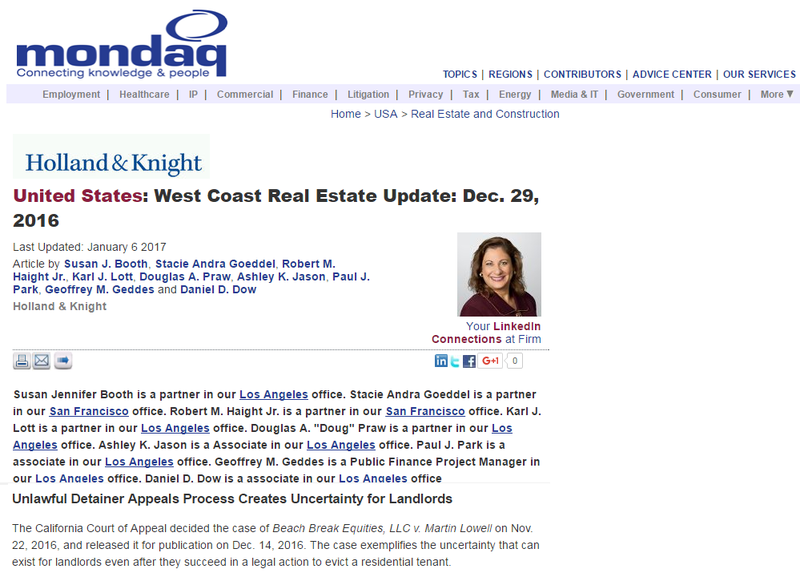The California Court of Appeal decided the case of Beach Break Equities, LLC v. Martin Lowell on Nov. 22, 2016, and released it for publication on Dec. 14, 2016. The case exemplifies the uncertainty that can exist for landlords even after they succeed in a legal action to evict a residential tenant.
The landlord, Beach Break Equities, filed an unlawful detainer action to evict Martin Lowell and recover possession of the premises rented by Lowell. The landlord was granted summary judgment in the unlawful detainer action, and Lowell appealed. While Lowell's appeal was pending, the landlord evicted Lowell and sold the property to a third party. On appeal, the court ruled not only that summary judgment should not have been awarded to the landlord, but also that the landlord owed restitution to Lowell for evicting him improperly.
The lesson to be learned by landlords from this case is that even if a landlord succeeds in a legal action to evict a tenant, evicting that tenant prior to the expiration of the tenant's time to appeal could expose the landlord to liability for restitution. Although an unlawful detainer action is an expedited proceeding, the appeals process for an unlawful detainer action is not. Therefore, a tenant has at least 60 days to appeal a decision in an unlawful detainer action. During this time, it may be in the landlord's best interest to leave the tenant in the premises to avoid potential liability for evicting the tenant too soon if the unlawful detainer decision is later reversed.
California State Board of Equalization Invalidates "Drop and Swap" 1031 Exchange
Owners of real property can defer tax on gain from the sale of such property by engaging in a 1031 exchange, so named because the deferral is made pursuant to Section 1031 of the Internal Revenue Code (IRC). However, there are times when members of an ownership group would rather not defer their tax liability. Enter the "drop and swap" 1031 exchange. In a typical drop-and-swap 1031 exchange, the property is distributed from the holding entity, such as an LLC or LP, to the individual members or partners as tenants in common. The members then collectively sell the property, choosing individually whether to sell their share as part of a taxable sale or as a 1031 exchange.
The main issue created by a drop-and-swap 1031 exchange is that taxing authorities can argue that the members did not own the property for "investment," which is a requirement of IRC Section 1031. A very brief holding period between distribution of the property to the members and the sale of the property could be considered inconsistent with the concept of holding property for investment purposes. The Internal Revenue Service (IRS) initially used this argument to impose tax on drop-and-swap 1031 exchanges, but later gave up such efforts after losing a couple of cases in court. The California Franchise Tax Board, however, has persisted in challenging taxpayers who engage in drop-and-swap 1031 exchanges.
Recently, the California State Board of Equalization (BOE) heard a drop-and-swap case, In re Giurbino, in which the property was sold only days after it had been distributed to the members of the LLC holding entity. Instead of determining that tax was owed because the property was not held for investment, the BOE concluded that tax was owed because the LLC – not its members – was the actual seller of the property. The court said that by the time the property was deeded to the members of the LLC, "the sale of the property was practically certain to be completed."
This ruling shows the importance of distancing the holding entity from the property as much as possible when conducting a drop-and-swap 1031 exchange. This distance can be created not only by distributing the property to the individual members or partners as far in advance of the exchange as possible, but also by ensuring that the holding entity is not a party to any of the transaction documents.
Congress Extends EB-5 Program
Congress recently extended the EB-5 program until April 28, 2017, as part of its "Continuing Resolution" to extend funding for the federal government. The EB-5 program grants green cards to foreign investors who invest at least $1,000,000 (or $500,000 in certain areas with high unemployment rates) in projects within the United States that create permanent jobs. Although there had been some talk of increasing the minimum investment requirements to $800,000 in high unemployment areas and $1,200,000 in low unemployment areas, the thresholds were left unchanged for the time being. It is expected that prior to April 28, 2017, Congress will pass a full budget for the fiscal year that could include a comprehensive EB-5 reform package.
Mentions
States
- New York
Videos





Subscribe for News
Site Digest
Join Professionals on EB5Projects.com →
Securities Disclaimer
This website is for informational purposes only and does not constitute an offer or solicitation to sell shares or securities. Any such offer or solicitation will be made only by means of an investment's confidential Offering Memorandum and in accordance with the terms of all applicable securities and other laws. This website does not constitute or form part of, and should not be construed as, any offer for sale or subscription of, or any invitation to offer to buy or subscribe for, any securities, nor should it or any part of it form the basis of, or be relied on in any connection with, any contract or commitment whatsoever. EB5Projects.com LLC and its affiliates expressly disclaim any and all responsibility for any direct or consequential loss or damage of any kind whatsoever arising directly or indirectly from: (i) reliance on any information contained in the website, (ii) any error, omission or inaccuracy in any such information or (iii) any action resulting therefrom.



